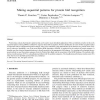Free Online Productivity Tools
i2Speak
i2Symbol
i2OCR
iTex2Img
iWeb2Print
iWeb2Shot
i2Type
iPdf2Split
iPdf2Merge
i2Bopomofo
i2Arabic
i2Style
i2Image
i2PDF
iLatex2Rtf
Sci2ools
JBI
2008
2008
Mining sequential patterns for protein fold recognition
Protein data contain discriminative patterns that can be used in many beneficial applications if they are defined correctly. In this work sequential pattern mining (SPM) is utilized for sequence-based fold recognition. Protein classification in terms of fold recognition plays an important role in computational protein analysis, since it can contribute to the determination of the function of a protein whose structure is unknown. Specifically, one of the most efficient SPM algorithms, cSPADE, is employed for the analysis of protein sequence. A classifier uses the extracted sequential patterns to classify proteins in the appropriate fold category. For training and evaluating the proposed method we used the protein sequences from the Protein Data Bank and the annotation of the SCOP database. The method exhibited an overall accuracy of 25% in a classification problem with 36 candidate categories. The classification performance reaches up to 56% when the five most probable protein folds are...
Fold Recognition | JBI 2004 | JBI 2008 | Protein | Protein Data |
| Added | 13 Dec 2010 |
| Updated | 13 Dec 2010 |
| Type | Journal |
| Year | 2008 |
| Where | JBI |
| Authors | Themis P. Exarchos, Costas Papaloukas, Christos Lampros, Dimitrios I. Fotiadis |
Comments (0)

